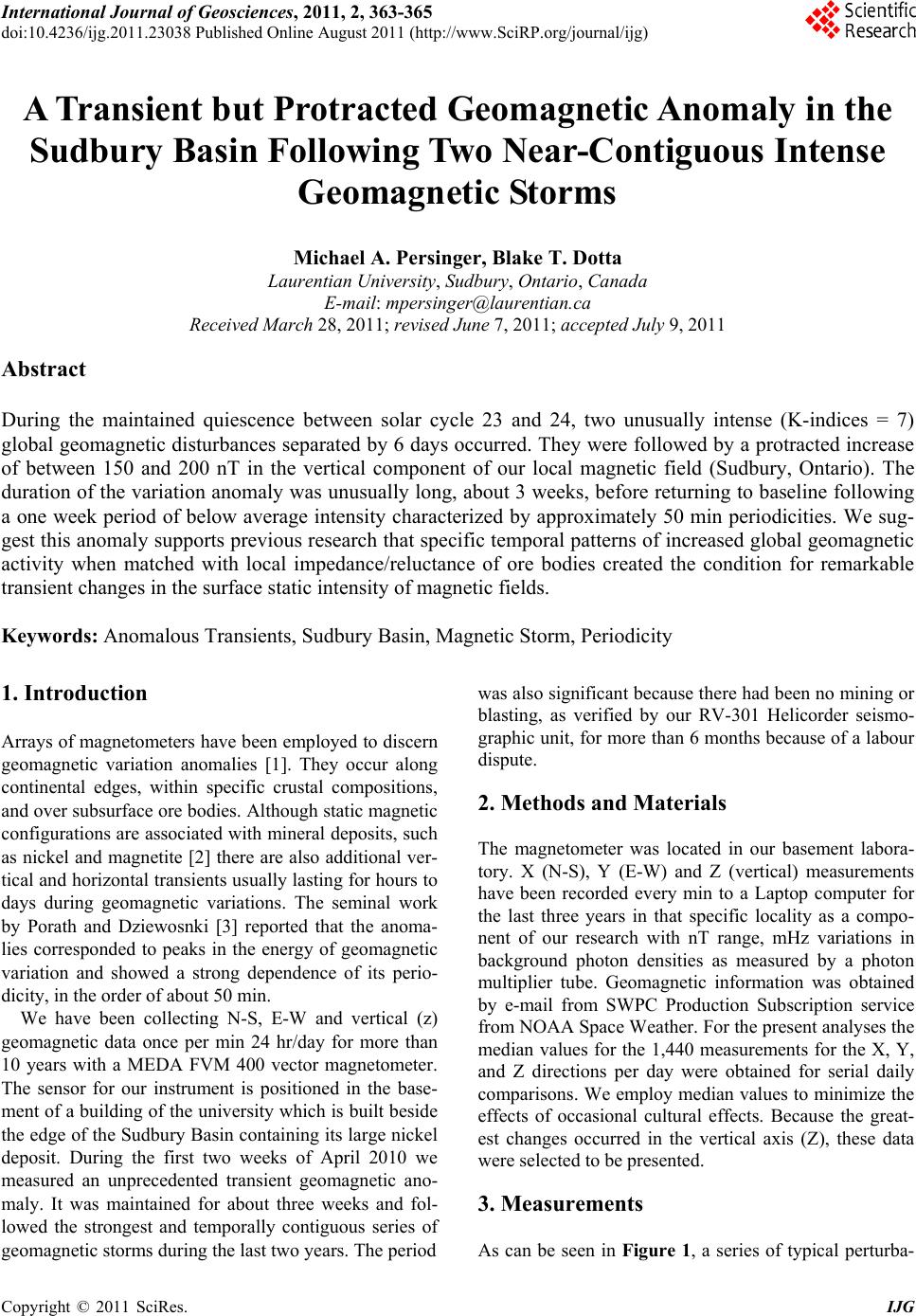
International Journal of Geosciences, 2011, 2, 363-365
doi:10.4236/ijg.2011.23038 Published Online August 2011 (http://www.SciRP.org/journal/ijg)
Copyright © 2011 SciRes. IJG
A Transient but Protracted Geomagnetic Anomaly in the
Sudbury Basin Following Two Near-Contiguous Intense
Geomagnetic Storms
Michael A. Persinger, Blake T. Dotta
Laurentian University, Sudbury, Onta rio, Canada
E-mail: mpersinger@laurentian.ca
Received March 28, 2011; revised June 7, 2011; accepted July 9, 2011
Abstract
During the maintained quiescence between solar cycle 23 and 24, two unusually intense (K-indices = 7)
global geomagnetic disturbances separated by 6 days occurred. They were followed by a protracted increase
of between 150 and 200 nT in the vertical component of our local magnetic field (Sudbury, Ontario). The
duration of the variation anomaly was unusually long, about 3 weeks, before returning to baseline following
a one week period of below average intensity characterized by approximately 50 min periodicities. We sug-
gest this anomaly supports previous research that specific temporal patterns of increased global geomagnetic
activity when matched with local impedance/reluctance of ore bodies created the condition for remarkable
transient changes in the surface static intensity of magnetic fields.
Keywords: Anomalous Transients, Sudbury Basin, Magnetic Storm, Periodicity
1. Introduction
Arrays of magnetometers have been employed to discern
geomagnetic variation anomalies [1]. They occur along
continental edges, within specific crustal compositions,
and over subsurface ore bodies. Although static magnetic
configurations are associated with mineral deposits, such
as nickel and magnetite [2] there are also additional ver-
tical and horizontal transients usually lasting for hours to
days during geomagnetic variations. The seminal work
by Porath and Dziewosnki [3] reported that the anoma-
lies corresponded to peaks in the energy of geomagnetic
variation and showed a strong dependence of its perio-
dicity, in the order of about 50 min.
We have been collecting N-S, E-W and vertical (z)
geomagnetic data once per min 24 hr/day for more than
10 years with a MEDA FVM 400 vector magnetometer.
The sensor for our instrument is positioned in the base-
ment of a building of the university which is built beside
the edge of the Sudbury Basin containing its large nickel
deposit. During the first two weeks of April 2010 we
measured an unprecedented transient geomagnetic ano-
maly. It was maintained for about three weeks and fol-
lowed the strongest and temporally contiguous series of
geomagnetic storms during the last two years. The period
was also significant because there had been no mining or
blasting, as verified by our RV-301 Helicorder seismo-
graphic unit, for more than 6 months because of a labour
dispute.
2. Methods and Materials
The magnetometer was located in our basement labora-
tory. X (N-S), Y (E-W) and Z (vertical) measurements
have been recorded every min to a Laptop computer for
the last three years in that specific locality as a compo-
nent of our research with nT range, mHz variations in
background photon densities as measured by a photon
multiplier tube. Geomagnetic information was obtained
by e-mail from SWPC Production Subscription service
from NOAA Space Weather. For the present analyses the
median values for the 1,440 measurements for the X, Y,
and Z directions per day were obtained for serial daily
comparisons. We employ median values to minimize the
effects of occasional cultural effects. Because the great-
est changes occurred in the vertical axis (Z), these data
were selected to be presented.
3. Measurements
As can be seen in Figure 1, a series of typical perturba-